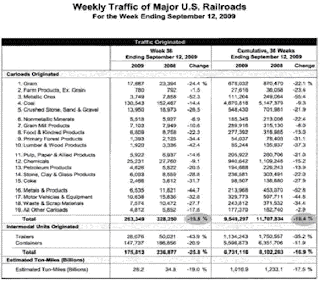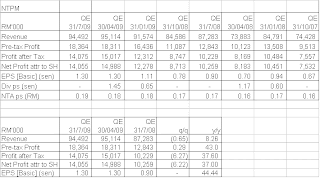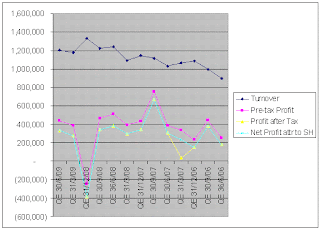BackgroundGeneral Corporation Bhd ('GCorp') is principally involved in construction, property development & investment, tyre manufacturing, shoe trading, confectionery manufacturing, hotel operation & quarrying. In the past few years, GCorp has benefited from strong contribution from its 52%-owned subsidiary, Low Keng Huat (Singapore) which experienced big jump in construction activities.
Recent Financial ResultsGCorp has just announced its results for QE31/7/2009. Its net profit increased by 113% q-o-q or 438% y-o-y to RM24.5 million while turnover increased by 86% q-o-q or 134% y-o-y to RM418 million. The improved performance is attributable to increased contribution from Low Keng Huat (Singapore).
 Table 1: GCorp's 8 quarterly results
Table 1: GCorp's 8 quarterly resultsI have appended below the chart of GCorp's top-line & bottom-line for the past 10 quarters which shows steady growth, except for a net loss attributable to the shareholders in QE31/1/2009 after netting off Minority Interest of RM21.2 million.
 Chart 1: GCorp's 10 quarterly resultsValuation
Chart 1: GCorp's 10 quarterly resultsValuationGCorp (closed at RM1.10 at the end of the morning session) is now trading at PE of 8.1 times (based on last 4 quarters' EPS of 13.5 sen). As a mid-size diversified group with a good growth track record, GCorp deserves to be valued at a higher PE multiple, say 10-12 times. Assuming a PE multiple of 10 times, GCorp's fair value is about RM1.35.
The present market capitalization of GCorp is only RM327 million. This is derived at as follows: Outstanding share capital of 297.1 million units at RM1.10 per unit. Its 52%-stake in Low Keng Huat (Singapore) alone is worth RM343.5 million today. The present market capitalization of Low Keng Huat (Singapore) is S$269.7 million or RM660.7 million This is arrived at as follows: Outstanding share capital of 738.8 million units, valued at S$0.365 per unit and then converted to RM at an exchange rate of RM2.45:S$1.00. As such, GCorp is now trading at about the value of its stake in Low Keng Huat (Singapore), with no consideration given to its other businesses.
Technical Outlookfrom the weekly chart below, we can see that GCorp has broken above its medium-term downtrend line at RM1.00 in July. Its immediate horizontal support is at RM1.10 while resistance is at RM1.20.
 Chart 2: GCorp's weekly chart as at Sept 28, 2009 (Source: Quickcharts)Conclusion
Chart 2: GCorp's weekly chart as at Sept 28, 2009 (Source: Quickcharts)ConclusionBased on steady financial performance, attractive valuation & positive technical outlook, GCorp is a good stock for medium-term investing.



















































